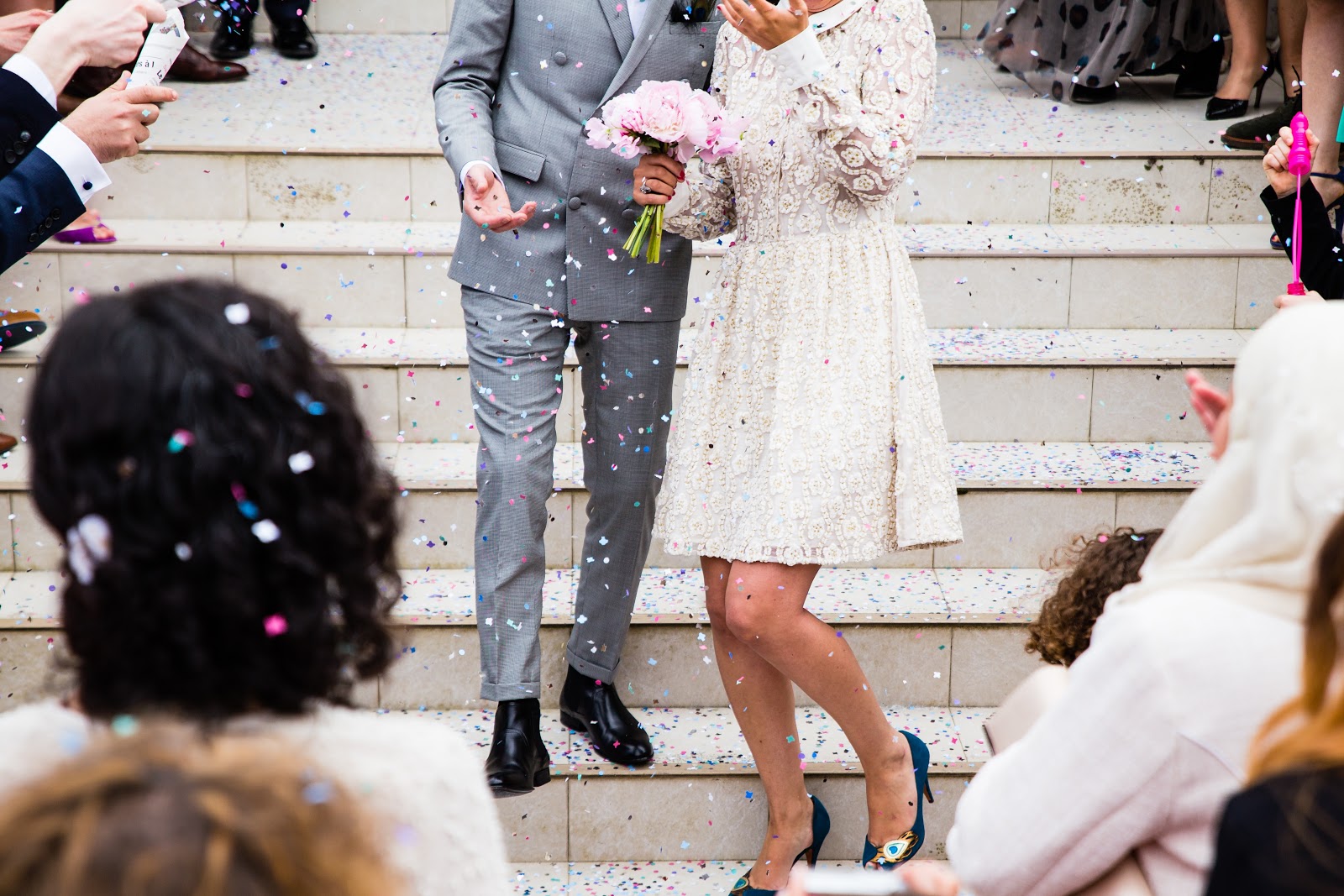Last Updated on August 26, 2024 by Joy Editors
Believe it or not, the wedding ceremony outline is one of the most significant parts of your big day. After all, it’s the portion of your wedding when you actually get married. From the processional order to how long you’ll reserve the venue, your ceremony requires more planning and attention than you think.
But not to panic! We’ve created this stress-free guide (plus an order of events template) to help you envision your wedding ceremony order from start to finish. Pull inspiration from cultural traditions, or mix and match to make it your own.
Traditional Wedding Ceremony Order
Wedding ceremonies can vary widely across different countries, generations, and religions. The following ceremony outline is the most traditional one in the United States. Here’s a quick snapshot of the order of events:
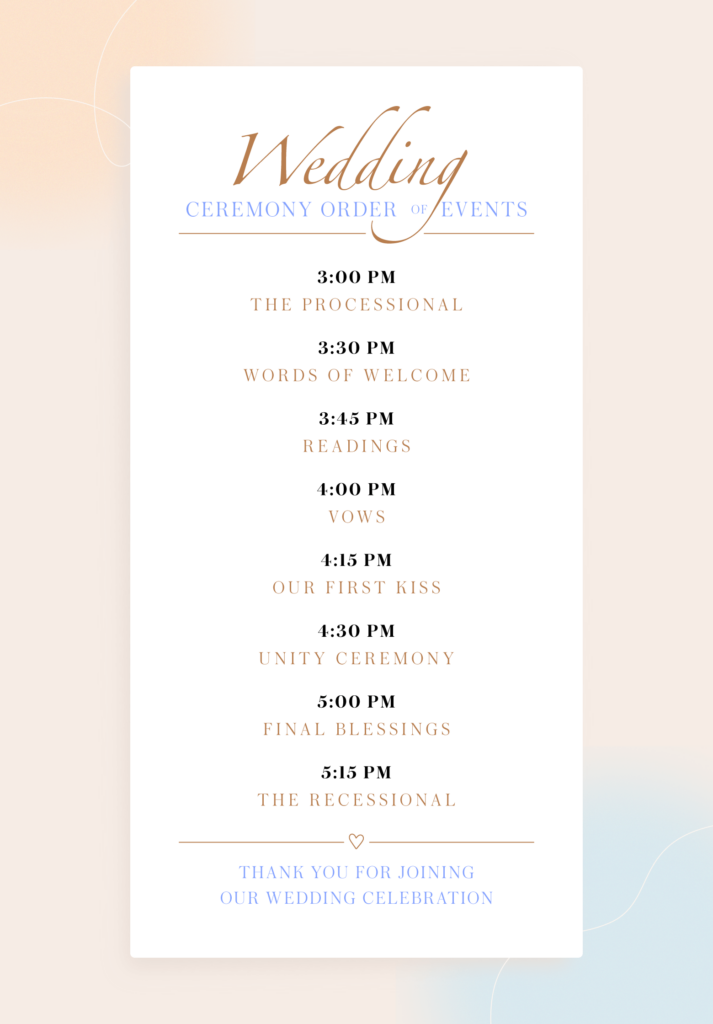
1. Seating of guests
Wedding guests will start gathering around the ceremony site up to 45 minutes before the ceremony begins. Ushers will help guide guests to their seats. They should seat people front to back, with the exception of the first row or two. These rows should be reserved for the immediate family. You may want to reserve some seats for the flower girl or ring bearer’s parents or anyone participating in the ceremony as well.
For traditional Christian weddings, the bride’s family and friends are seated on the left. The groom’s family and friends are seated on the right. In the Jewish tradition, the sides are reversed, with the bride’s side on the right and the groom’s on the left.
A more contemporary trend is to reserve the front rows for immediate family and have everyone else sit where they like. Some popular verbiage for signage includes:
- “Choose any seat in the room. You’re loved by both the bride and groom.”
- “Pick a seat, not a side. We’re all family once the knot is tied.”
2. Seating of parents
Parents and grandparents should be seated last. For Christian ceremonies, grandparents are seated, then the father and mother of the groom, and then the mother of the bride. In Jewish tradition, the parents walk in with the bride. They stand under the chuppah during the ceremony.
3. The processional
The wedding processional order can be arranged in several ways. First, the officiant takes their place at the altar. Typically, the groom will stand to their left. The best man may come out at this point, or you may have him enter with the rest of the groomsmen.
Once they’re arranged, the rest of the wedding party arrives. You may have all the groomsmen walk down first, followed by the bridesmaids. Or, groomsmen may escort bridesmaids. Either way, the wedding party will take their place on either side of the groom, facing guests. The maid or matron of honor is the last bridesmaid to take her place.
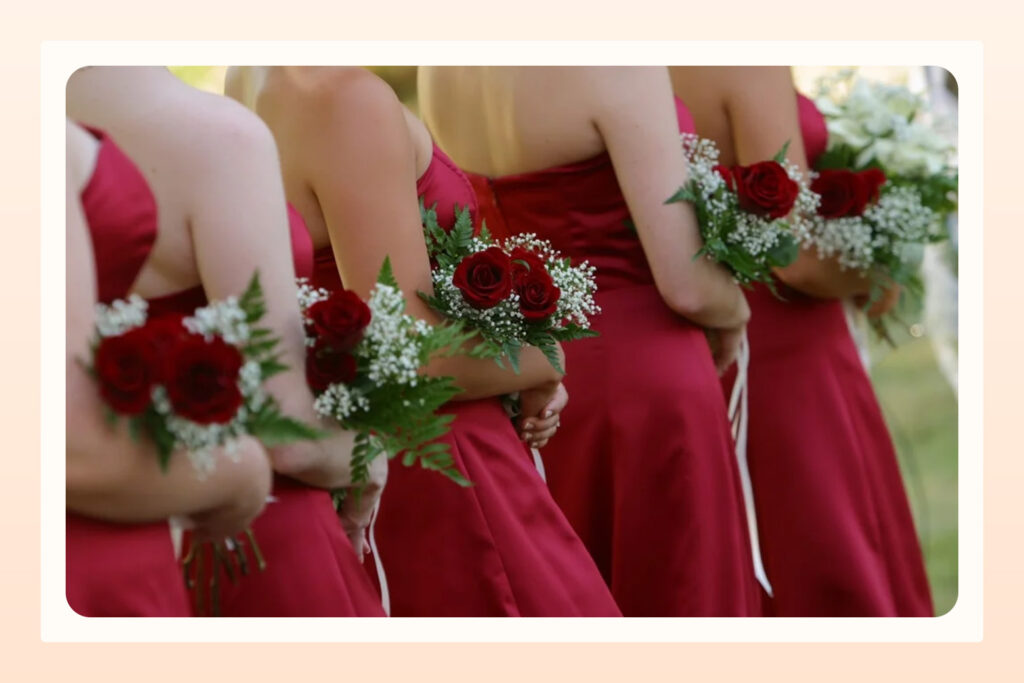
Then, the little ones enter if you’re having them. The ring bearer and flower girl are the last to proceed before the bride. Last, and certainly not least, is the bride. Traditionally, Christian services have the bride escorted by her father on his left arm. Jewish parents both walk their daughter down the aisle.
Today, many of these options are adjusted to the bride’s and groom’s wishes. Brides of any religion may choose to have both parents walk her down the aisle. Or, same-sex couples might walk together or enter from opposite sides of the venue. They may or may not be escorted by a parent, or both.
Once the bride reaches the altar, the groom will typically hug or shake hands with her parents. The bride will hug and kiss her parents and give her bouquet to the maid of honor. Then, the couple will hold hands.
4. The officiant’s remarks
Once everyone has taken their place, the ceremony begins with the officiant’s opening remarks. They may lead with “We’re gathered here today” or something else. Then, they will address the couple. Depending on the ceremony you have decided on with your officiant or place of worship, this can be brief or lengthy. Your officiant will probably reinforce the importance of the upcoming vows. They may also talk about love and the duties of each partner in marriage.
Religious ceremonies typically include some scripture during this time. If you’re having anyone do a reading, this would take place at this point as well. If you’re doing a unity candle or sand ceremony, now is the time to do so.
5. The vows
After the officiant’s remarks, you will now exchange vows. These can be prepared by the officiant and read aloud. Or, you might decide to write your own. You can also choose to read your own vows as well as reciting traditional vows. However you express them, these are the promises you are making to one another for your marriage.
6. The ring exchange
Once you’ve exchanged your vows, the wedding officiant will instruct you to exchange rings. Most couples choose to have the best man hang on to the wedding bands until now. You will repeat a phrase such as “I give this ring as a sign of my love” or “With this ring, I thee wed.”
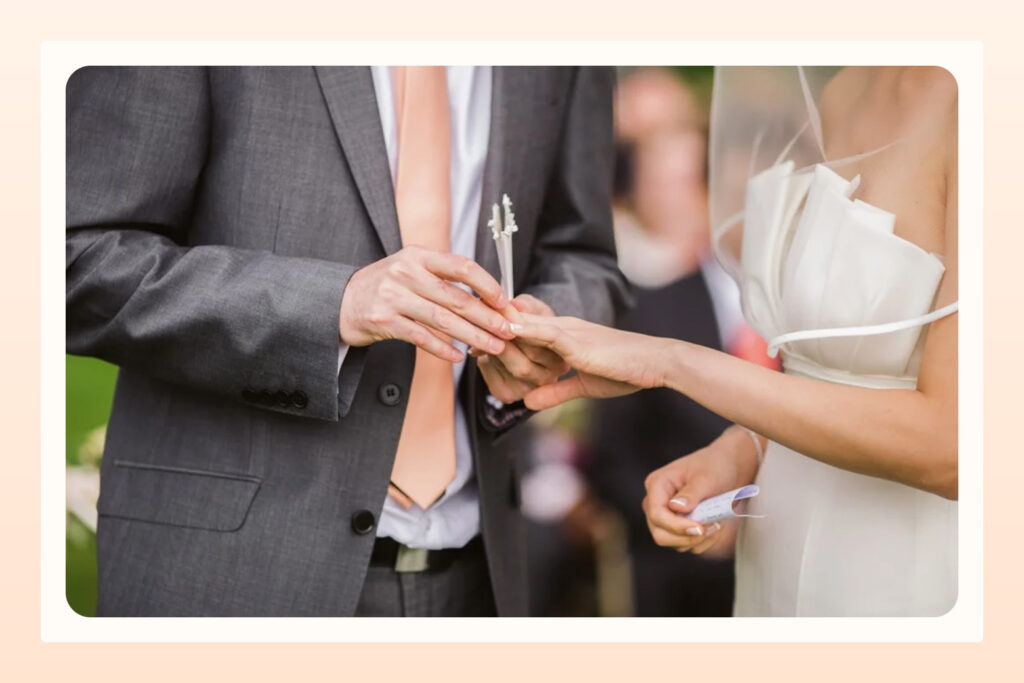
7. The pronouncement of marriage
The officiant says those words you’ve been imagining since your engagement: “I now pronounce you husband and wife” or “I now pronounce you married.”
8. The first kiss
Ladies and gentlemen, the moment you’ve been waiting for. After the declaration of marriage, the bride and groom — or bride and bride, or groom and groom — kiss. Guests break into applause.
9. Closing remarks
Your officiant will say their last few words to wrap up the ceremony. In religious weddings, there is often a blessing spoken over the couple.
10. Recessional
Cue the celebratory music! Your officiant will introduce you as a married couple for the first time. As newlyweds, you will lead the wedding party out in reverse order. If bridesmaids and groomsmen walked in separately, they would still typically escort each other out.
Nontraditional/Modern Ceremony Outline
Modern wedding ceremonies are, of course, a more personalized processional order. The focus is on creating a meaningful and unique experience for you, your spouse-to-be, and the guests.
A typical order might include the officiant entering first, followed by the groom and groomsmen, then the bridesmaids and maid of honor. If there is a ring bearer and flower girl, they will follow the wedding party.
The bride enters last, escorted by her chosen family member or walking alone. The best part about modern ceremonies is that anything goes! Couples are free to customize the processional how they like.

Jewish Wedding Ceremony Outline
A traditional Jewish wedding ceremony, or Chuppah, follows a meaningful and symbolic order of events and ends with a joyful celebration. Here’s an example of the order of events in a Jewish ceremony:
- Private signing of the Ketubah, a Jewish marriage contract
- The Bedeken (ritual of the groom veiling the bride)
- The processional
- Entrance of the couple under the Chuppah
- The exchange of rings
- The Seven Blessings (Sheva Brachot)
- The breaking of the glass
- First Kiss
- Recessional and start of celebration
Consider this wedding ceremony order if you’d like to incorporate elements of Jewish tradition to honor your or your future spouse’s culture.
Catholic Ceremony Order
A traditional Catholic wedding ceremony almost always takes place in the church and incorporates elements of the Catholic Mass. The marital union is viewed as a holy covenant between the couple and God, and readings of scripture typically replace the writing of personal vows. This religious ceremony typically goes as follows:
- The processional of the wedding party
- Introductory remarks from the officiant
- Biblical readings and homilies leading
- Vow exchange (Rite of Marriage) and ring ceremony
- Liturgy of the Eucharist
- Blessing of the couple
- The first kiss
- Recessional
While rooted in the religion, Catholic wedding ceremonies are also considered traditional, such as to honor the family.
Hindu Wedding Ceremony Order
A traditional Hindu wedding ceremony is usually a vibrant and elaborate affair, often spanning multiple days. The processional order can vary by region and family tradition but generally includes the following:
- The groom’s arrival (Baraat)
- A welcoming ceremony (Milni)
- The bride’s entrance
- Key rituals (e.g., the Kanyadaan or “giving away the bride,” the Jaimala “garland exchange,” etc.)
- Final blessings from elders of the families
- Recessional
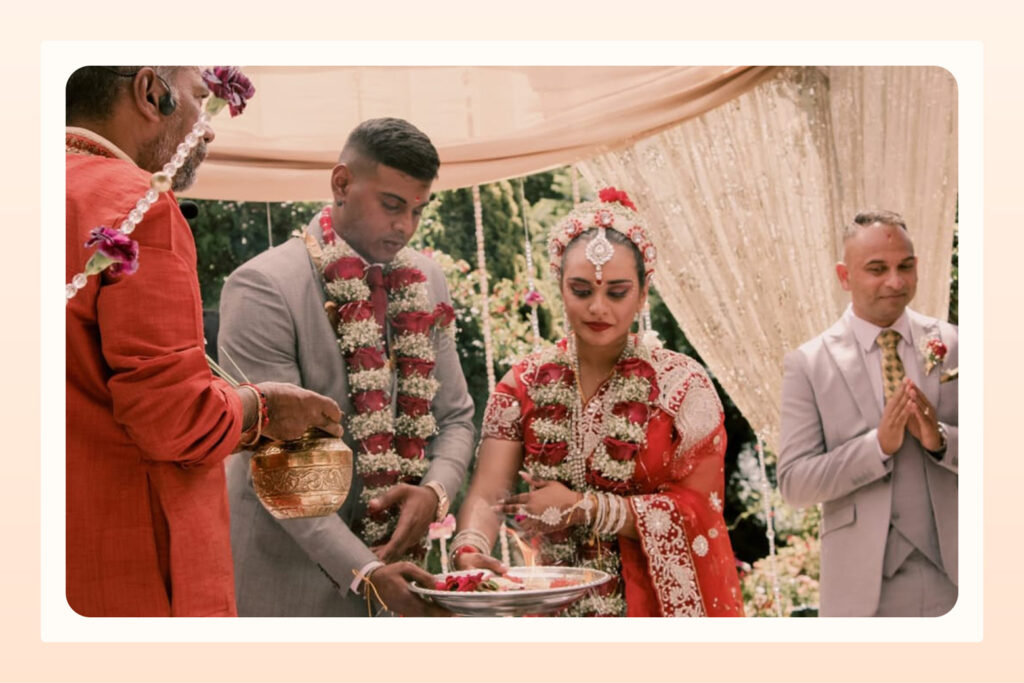
There are also several pre-wedding and post-wedding ceremonies in the Hindu religion and culture, allowing an extended celebration for the couple’s marital union.
Additional Tips for Planning Your Wedding
Trying to determine how to incorporate both traditional and personal ideas in your wedding ceremony? Here are a few tips to help.
- Consider your venue: The size and layout of your ceremony space will influence the number of people who can comfortably fit in the processional, as well as the activities you intend to do.
- Involve your officiant: Your wedding officiant can offer suggestions and guidance on traditional or non-traditional ceremony options. Pick their brain about the plans and timeline.
- Practice makes perfect: A rehearsal can help everyone involved understand their roles and timing. You can invite them to a rehearsal dinner to go over the processional order before the big day.
- Be flexible: Unexpected events (like rain) may happen and are out of your control. Always be prepared to adjust the ceremony plans if necessary.
Ultimately, the most important thing is that you and your future spouse feel comfortable and confident about walking down the aisle. Choose a processional order that works for you two.
Plan Every Wedding Detail With Joy
When planning your wedding ceremony, know that you don’t have to adhere to any rules. You can follow any wedding ceremony order that adds structure and makes the most sense to you on your big day.
From stationery designs to guest communication, Joy has all the tools you need to plan your wedding your way.
Wedding Ceremony Outline FAQ
How do you determine your processional order?
Choosing your wedding processional order typically involves a blend of your tradition and personal preference. Consider the size of your wedding party, the roles of family members, and any cultural or religious customs you want to honor. Ultimately, there is no right or wrong order, as long as the processional should reflect your unique story and set the stage for your ceremony.
How should the wedding party stand?
From the center going outward, the maid or matron of honor and best man stand on either side of the couple. After that, the rest of the standing order is completely up to your preference. You can also choose the order of your wedding party by relationship, such as placing a closer friend or sibling in the center. Or, to keep it simple (and avoid hurt feelings), you can arrange everyone by height.
What do you do if your wedding party is uneven?
If your wedding party is uneven, you can have groomsmen and bridesmaids walk separately or in groups of three. There are also other clever workarounds. Here are some examples:
- Have a groomsmen escort the mother of the bride.
- Have two groomsmen escort a bridesmaid.
- Have two bridesmaids on each arm of one groomsman.
- Have a bridesmaid or groomsman walk with the flower girl or ring bearer.


